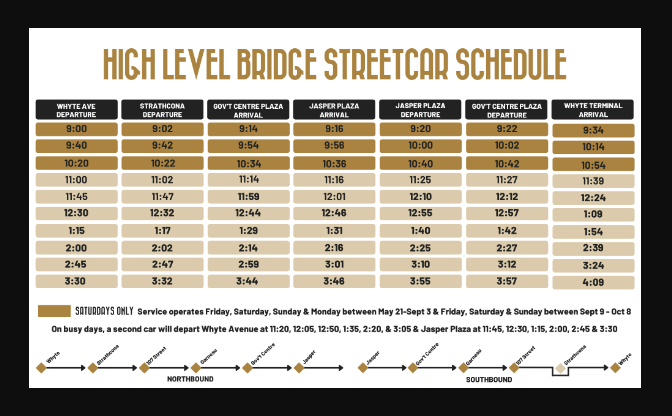The rhythmic clickety click of the High Level Bridge streetcar relaxes my mind as I ride along its historic route. I take in the textures of the streetcar’s hardwood paneling and the rough weave of the seat upholstery, enjoying the rattle of the windowpanes in their frames as we pass over the North Saskatchewan River far below. On the neighbouring Menzies Bridge, I see the light rail train (affectionately called the LRT by Edmontonians) pass by – it looks miniature from the great height at which the streetcar crosses the river, 156 feet above its wide banks.
Given the subzero temperature for a good chunk of the year, the Edmonton Radial Railway Society opts to run streetcars during the warm season: from May long weekend to Thanksgiving weekend in October. While the majority of the operating streetcar fleet services the Fort Edmonton Park line, three regular cars cover the High Level Bridge route. The metropolitan flavour of Edmonton is reflected in these cars, with xMelbourne 930 (from Australia), xOsaka 247 (from Japan), and xEdmonton 33.
NOTE – Edmonton Radial Railway Society mainly uses “xEdmonton Streetcar 33” to denote that they are no longer in original service. The “x” stands for “former.”

Edmonton Radial Railway Society.
May 2023. Photo: Abbie Schenk.
Streetcar xEdmonton 33 looks shiny and new, despite being 110 years old, with a red and green exterior and high gloss varnish in the wood-paneled interior. Throughout the life of Streetcar xEdmonton 33 this was not always the case. Over a hundred years of use has flowed through this public transit vehicle and many hands and feet have touched its surfaces. Streetcar xEdmonton 33 has taken countless people to the places they needed to go within the city of Edmonton, and many others have worked to get this vehicle back to its original working condition.
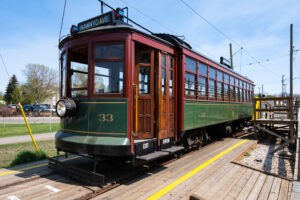
Edmonton RadialRailway Society.
May 2023. Photo: Abbie Schenk
Back in 1911, on the banks of the North Saskatchewan River, two distinct cities looked across from each other over an expanse of fast-moving water. Edmonton on the north side, and Strathcona on the south. Due to their size and rapid growth, the two cities amalgamated in 1912. The 1910s and 1920s were economic boom years for Edmonton, with many people flocking to the city looking for new opportunities.
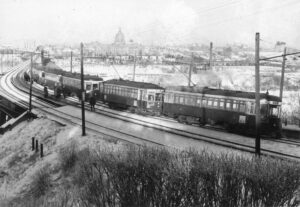
City of Edmonton Archives. EA-599-1.
Personal vehicles were still a pie in the sky dream that would not be realized for many until the 1950s. Public transit was the way to get from here to there within the newly joined city of Edmonton. Cross river trips and getting from neighbourhood to neighbourhood were carried out with over-packed electric streetcars that often had to pass by patient people waiting at streetcar stops. At the time, however, it was apparent that the number of streetcars that the city had in service were inadequate for the demand.
Nationwide, the demand for more streetcars in large urban centres was very high and getting an order of new cars in any kind of realistic time frame was not possible for most Canadian streetcar manufacturers. To this end, the City of Edmonton chose to accept a contract with the St. Louis Car Company in Missouri, over other more local offers. An order (number 910) was placed in February 1912 for fifteen streetcars, numbers 32 to 46, costing around $6200 each.
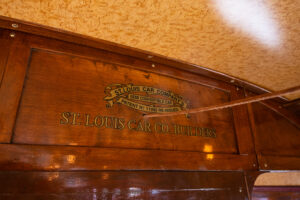
Streetcar xEdmonton 33.
May 2023. Photo: Abbie Schenk.
In early June, eight of the promised cars were in Edmonton, and by June 23rd, those street cars were on the street, full to capacity, contributing to the human ebb and flow that coursed through the city. During the first winter of its service, the prairie weather was too harsh for the factory-made electric heater, leading to Streetcar xEdmonton 33 and its fellows to have coal burning stoves installed.
Notably, the #910 order of streetcars were double-ended. The purpose of having two ends was to reverse the streetcar on its route once the end of the line was reached. When the car reached the end of the line, the operators would raise one pole at one end and lower the pole at the other end, then walk the controller key over to be inserted into place. In the 1910s and 1920s, the City of Edmonton had no plans for reversible route rail construction. Due to the Edmonton Radial Railway’s introduction of track turnaround loops and wyes built into the rail lines and even some routes designed as beltlines (routes which looped through several neighbourhoods with cars that operated on both clockwise and counter-clockwise directions), by 1917, several streetcars were one-man operated and by 1920, all service routes were single-car. By the 1930s, most of the St. Louis cars were converted to single ended cars, as more turning loops and wyes had by then been installed at the ends of streetcar routes.

The modification of a double ended car to a single ended one increased the seating to 50 passengers, a much needed boost since ridership only kept increasing with the passing decades. Even when newer modes of public transit, such as trolley coaches and gas-powered buses of the 1930s and 1940s, started to replace the electric streetcars, all vehicles of the transit system remained overcrowded.

May 2023. Photo: Abbie Schenk.
xEdmonton 33 remained in active service until 1951. The last few years of its official run were spent on the routes that served the Calder area because more turning loops and wyes had been built into the north side lines by that time. The Calder stub remained in service as there were no paved roadways in the area and buses would not be able to operate. After xEdmonton 33’s official retirement, along with the other St. Louis cars, it had all of its electrical parts, and wheel components removed and sold for scrap.
The body of xEdmonton 33 was sold and put out to pasture on a farm, like its sister car xEdmonton 35.


xEdmonton Streetcar 35 in 1949. Put out to pasture. Credit to N. F. Corness. Edmonton Radial Railway Society (ERRS).
Photo of xEdmonton Streetcar 33 in 1951 (abandoned condition) on a farm south of Willingdon, AB prior to recovery by the Edmonton Radial Railway Society (ERRS). Photo: George Buck.
Restoration and Rebuilding
On May 1, 2010, xEdmonton 33 proudly made its first run on the tracks in over 50 years, in Fort Edmonton Park. The following year, xEdmonton 33 was moved to the High Level Bridge route where it has been a staple of the fleet ever since. Most recently, during the off-season of 2019, underwent general maintenance and had some touchups done.

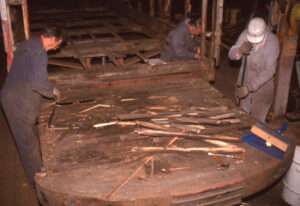
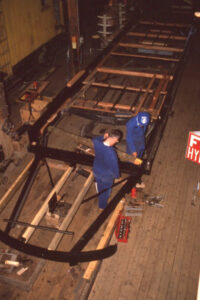
In total the rebuild of xEdmonton 33 took 17 years, 35,000 volunteer hours and $151,000 to bring it back to its original factory state.
$50,000 for the rebuild came from the Provincial Grant from the Community Facility Enhancement Program in 1990 and the rest came out of the Edmonton Radial Railway Society’s annual budget.
By November, a new subfloor was in place and xEdmonton 33’s wooden frame was near completion the following spring. A slow labour of love, the car’s canvas roof was up and shading its volunteer workers by October 1995.
One of the unique characteristics of xEdmonton 33, its reversible seats, were taken from another car from the original 910 order, xEdmonton 34.
While much of the seating material could not be restored, any parts that could be used were retained.

May 2023. Photo: Abbie Schenk.
In January 1997, the folding exterior doors were installed, along with the windows and air compressor. Fast forward to January 2010 and the final touches like window blinds and hardware on the window frames were being added. Relying only on volunteer labour, the need to fabricate many of the mechanical and structural parts from scratch, as well as [funding grants from] which did not come on a constant schedule, this rebuild took over a decade to complete.

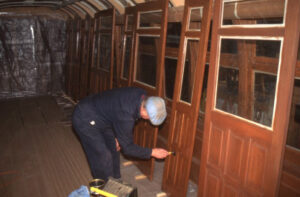

Attention to Detail
During the rebuild process several first attempts to fabricate parts from historical photo and machine plan sources turned out to be inaccurate. Sometimes it even took a third try to get things right. “Unfortunately, we did not get some of the structural and electrical stuff right the first time, and in some cases a second time. The [historical] pictures revealed that some wrong assumptions had been made about various component designs such as doors,” stated a volunteer.
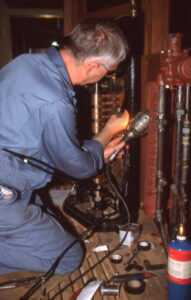
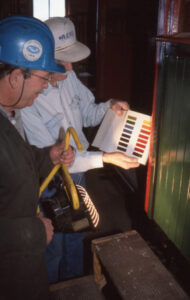
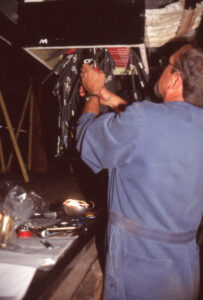
Barrie Fenby installs contacts for the motor field and armature wires in the controller of the ‘B’ end. August 15, 1998. Photo: Don Scafe.
Michael Jansson and Bill Betts compare the exterior paint of xEdmonton 33 to that in a 1910 Sherwin Williams paint catalogue. February 26, 2000. Photo: Don Scafe.
Hans Ryffel connects wires in the new terminal box below xEdmonton 33. August 1, 2009. Photo: Don Scafe.
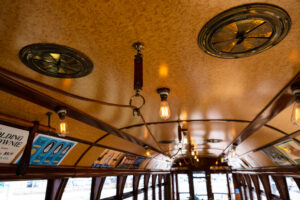
Basing educated guesses from examples of the modified xEdmonton 42, which had been retrofitted to be a single end car midway through its life as a public transit vehicle, turned out to be misleading more than once while rebuilding xEdmonton 33 to its earlier fresh-off-the-factory-line state.
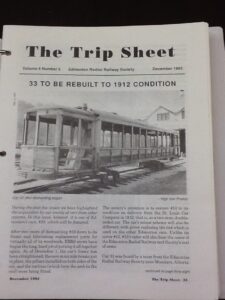
As two of the Edmonton Radial Railway Society volunteers said in the October 2010 Trip Sheet “xEdmonton 42 was not just an evil influence. It also had the power to confirm or refute suspicions about design questions. The original specifications on the number of lights and circuits were not clear…Those who first worked on the car assumed the light spacing and count should follow that of xEdmonton 42. Using a string light, I was able to identify the filled holes in the original board to discern the light placement pattern. There were 16 points where the original light socket bases had been screwed to the trim board.”
The retro-fitted xEdmonton 42 only had 5 or 6 interior light fixtures.
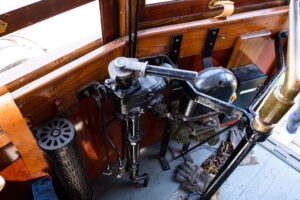
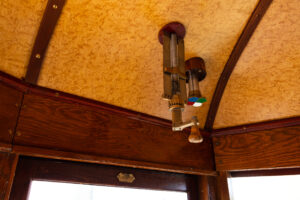
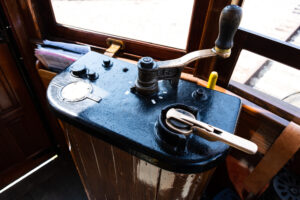


Hardware inside xEdmonton 33. Route line, colour lamp switches.
Exterior paint, woodwork, and City of Edmonton logo.
Operational mechanism in xEdmonton 33.
Handheld fare-box at the Strathcona Streetcar Barn & Museum. May 2023. Photos: Abbie Schenk
Another volunteer encapsulated it best, highlighting the “…the learning aspect of such an undertaking as a restoration/replication. This is what takes the energy and the focus. Learning how things were done in another age usually requires learning about the context on which things were done. … I had many of these eureka moments. They gave a human, political, industrial and business dimension to a time, an era, much as Fort Edmonton Park has been designed to do.”
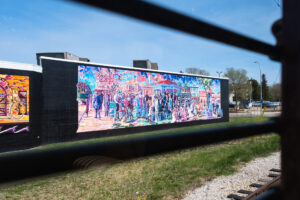
May 2023. Photo: Abbie Schenk.
Adeline Panamaroff. (2023)
RELATED INFORMATION & REFERENCES
A special thank you goes out in recognition to each and every one of the many volunteers that helped over the years of restoration work through the Edmonton Radial Railway Society. Your contributions are invaluable to this period of Edmonton history and the legacy left by those tracks. Thank you!
Edmonton Radial Railway Society meeting minutes 1981.
Report on the Edmonton Street Railway, Edmonton, Alberta. Wilson and Bunnell, 1938.
Tingley, K. W. (2011). Ride of the century: the story of the Edmonton Transit System. Edmonton Transit System. Book.
Schwarzkopf, T., & Hatcher, C. (1983). Edmonton’s electric transit: the story of Edmonton’s streetcars and trolley buses. Toronto, Canada: Railfare Enterprises Limited. Book.
Trip Sheet: newsletter of the Edmonton Radial Railway Society; 1993-2019.
Do you have a memory about Edmonton’s streetcars?
Share and tag your photos with us!
@YEGcityasmuseum
@YEGstreetcar
#yegstreetcar #yegheritage
